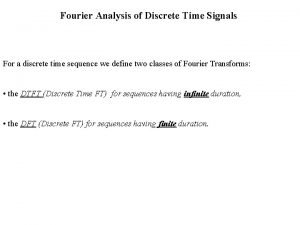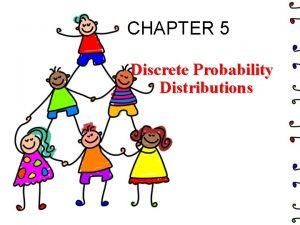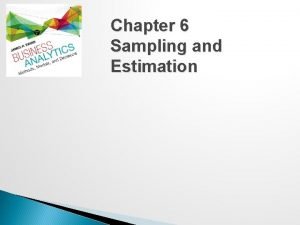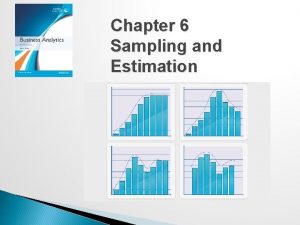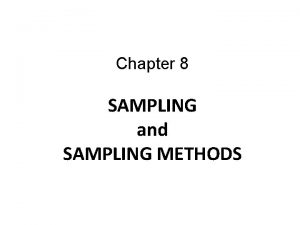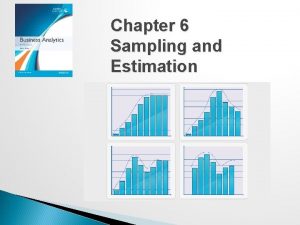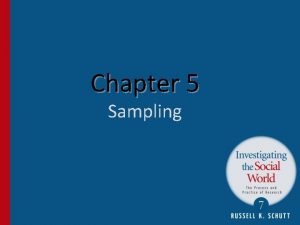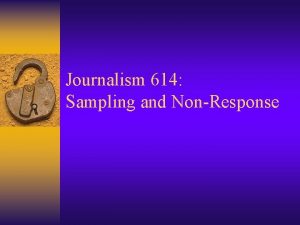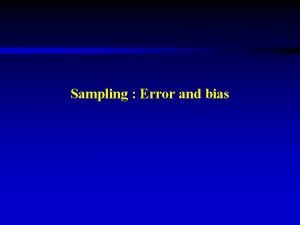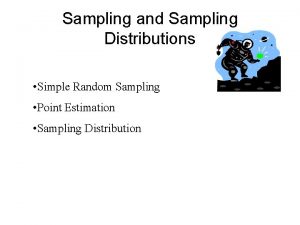CHAPTER 5 Discrete Sampling and Analysis of TimeVarying












- Slides: 12

CHAPTER 5 Discrete Sampling and Analysis of Time-Varying Signals • Analog recording systems, which can record signals continuously in time, • digital data-acquisition systems record signals at discrete times and record no information about the signal in between these times. Unless proper precautions are taken, this discrete Sampling can cause the experimenter to reach incorrect conclusions about the original analog signal.

In signal processing, sampling is the reduction of a continuous signal to a discrete signal. A common example is the conversion of a sound wave (a continuous signal) to a sequence of samples (a discrete-time signal). A sample refers to a value or set of values at a point in time and/or space. A sampler is a subsystem or operation that extracts samples from a continuous signal. A theoretical ideal sampler produces samples equivalent to the instantaneous value of the continuous signal at the desired points.




The data in Figure 5. 4, sampled a t 18 Hz, also represent a periodic wave. The apparent frequency is 8 Hz, the difference between the sampling rate and the signal frequency, and is again incorrect relative to the input frequency. These incorrect frequencies that appear in the output data are known as aliases. Aliases are false frequencies that appear in the output data, that are simply artifacts of the sampling process, and that do not in any manner occur in the original data.

Figure 5. 5, with a sampling rate of 20. 1 Hz, can be interpreted as showing a frequency of 10 Hz, the same as the original data. It turns out that for any sampling rate greater than twice fm, the lowest apparent frequency will be the same as the actual frequency. This restriction on the sampling rate is known as the sampling-rate theorem. This theorem simply states that the sampling rate must be greater than twice the highestfrequency component of the original signal in order to reconstruct the original waveform correctly. In equation form this is expressed as fs > 2 fm where fm is the signal frequency (or the maximum signal frequency if there is more than one frequency in the signal) and fs is the sampling rate.

Basics of Digital Recording CONVERTING SOUND INTO NUMBERS In a digital recording system, sound is stored and manipulated as a stream of discrete numbers, each number representing the air pressure at a particular time. The numbers are generated by a microphone connected to a circuit called an ANALOG TO DIGITAL CONVERTER, or ADC. Each number is called a SAMPLE, and the number of samples taken per second is the SAMPLE RATE. Ultimately, the numbers will be converted back into sound by a DIGITAL TO ANALOG CONVERTER or DAC, connected to a loudspeaker.

If there were only one bit in the number, the ultimate output would be a pulse wave with a fixed amplitude and more or less the frequency of the input signal. If there are more bits in the number the waveform is more accurately traced, because each added bit doubles the number of possible values.

Sample Rate The rate at which the numbers are generated is even more important than the number of bits used. Figure below illustrates this. If the sampling rate is lower than the frequency we are trying to capture, entire cycles will be missed, and the decoded result would be too low in frequency and might not resemble the proper waveform at all. This kind of mistake is called aliasing. If the sampling rate were exactly the frequency of the input, the result would be a straight line, because the same spot on the waveform would be measured each time. This can happen even if the sampling rate is twice the frequency of the input is a sine or similar waveform. The sampling rate must be greater than twice the frequency measured for accurate results. (The mathematical statement of this is the Nyquist Theorem. ) This implies that if we are dealing with sound, we should sample at least 40, 000 times per second.

• Digital devices usually require less maintenance than analog equipment. The electrical characteristics of most circuit elements change with time and temperature, and minor changes slowly degrade the performance of analog circuits. Digital components either work or don't, and it is much easier to find a chip that has failed entirely than one that is merely 10% off spec. Many analog systems are mechanical in nature, and simple wear can soon cause problems. Digital systems have few moving parts, and such parts are usually designed so that a little vibration or speed variation is not important. • In addition, digitally encoded information is more durable than analog information, again because circuits are responding only to the presence or absence of something rather than to the precise characteristics of anything. As you have seen, it is possible to design digital systems so that they can actually reconstruct missing or incorrect data. You can hear every little imperfection on an LP, but minor damage is not audible with a CD.

http: //www. youtube. com/watch? v=Ukot. Zy 3 l. Q qo&feature=related http: //www. youtube. com/watch? v=j. QDj. JRYm e. Wg&feature=related http: //www. youtube. com/watch? v=enss. Ch. K 1 F 0&feature=related http: //www. youtube. com/watch? v=3 I_e 7 g. Iyf Qg&feature=related
 A consumer confidence researcher asks several retailers
A consumer confidence researcher asks several retailers Convenience sampling example situation
Convenience sampling example situation Stratified sample vs cluster sample
Stratified sample vs cluster sample Yuli fajar susetyo
Yuli fajar susetyo Cluster vs stratified sampling
Cluster vs stratified sampling Probability sampling vs non probability sampling
Probability sampling vs non probability sampling Natural sampling vs flat top sampling
Natural sampling vs flat top sampling Fourier analysis of discrete time signals
Fourier analysis of discrete time signals Content analysis sampling
Content analysis sampling Discrete mathematics chapter 3 solutions
Discrete mathematics chapter 3 solutions Double implication
Double implication A survey from teenage research unlimited found
A survey from teenage research unlimited found Chapter 5 discrete probability distributions
Chapter 5 discrete probability distributions







